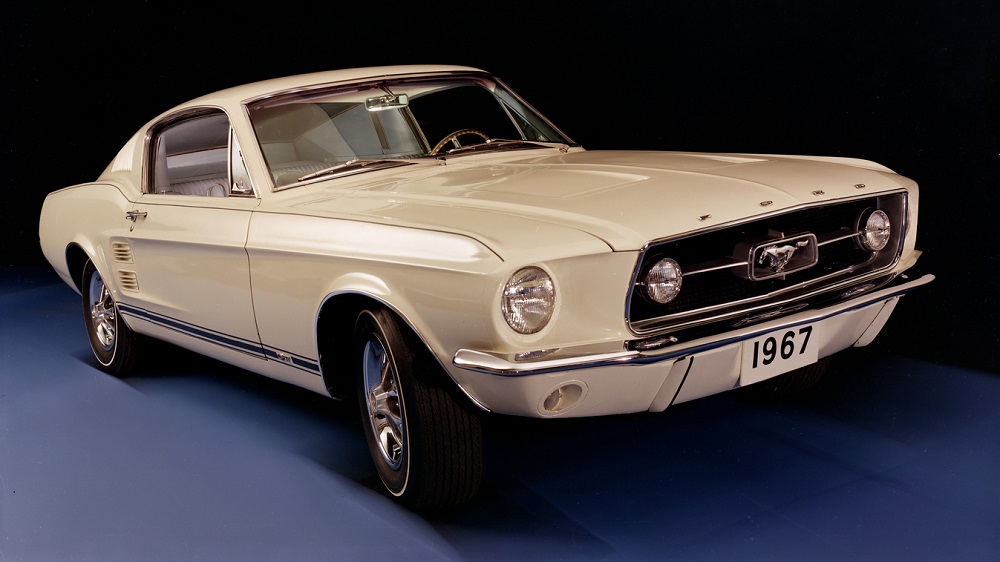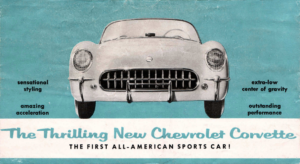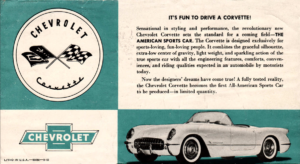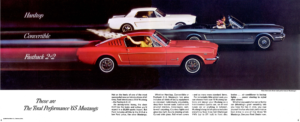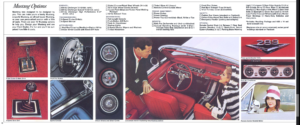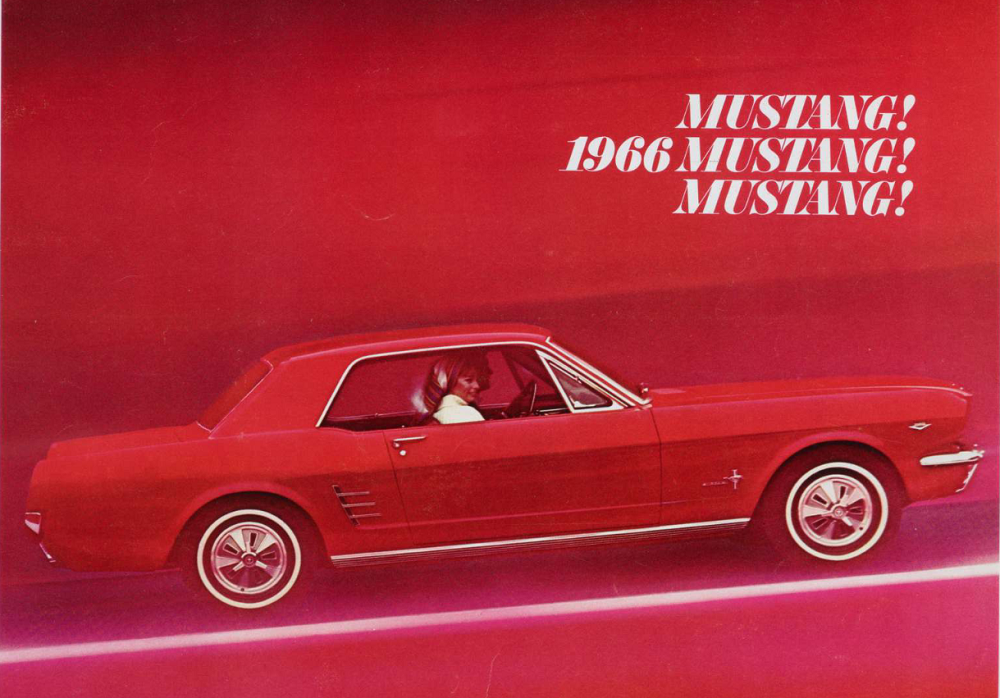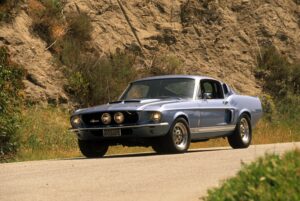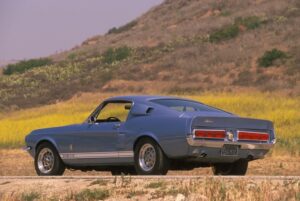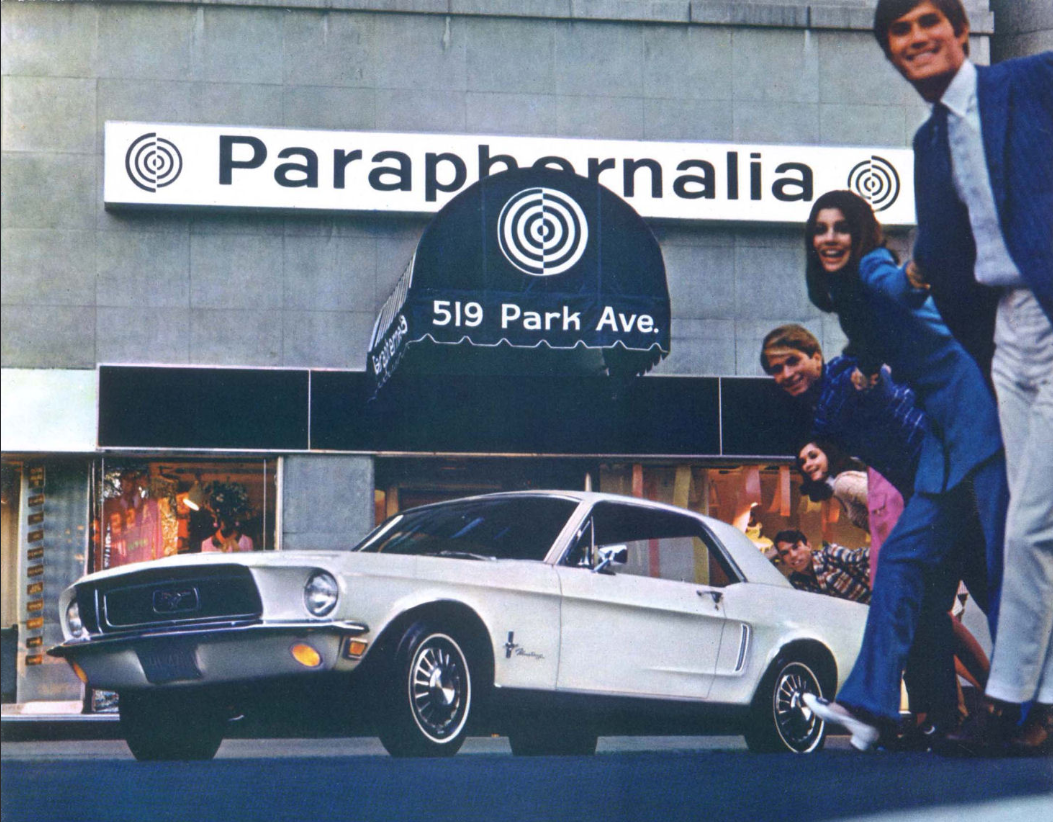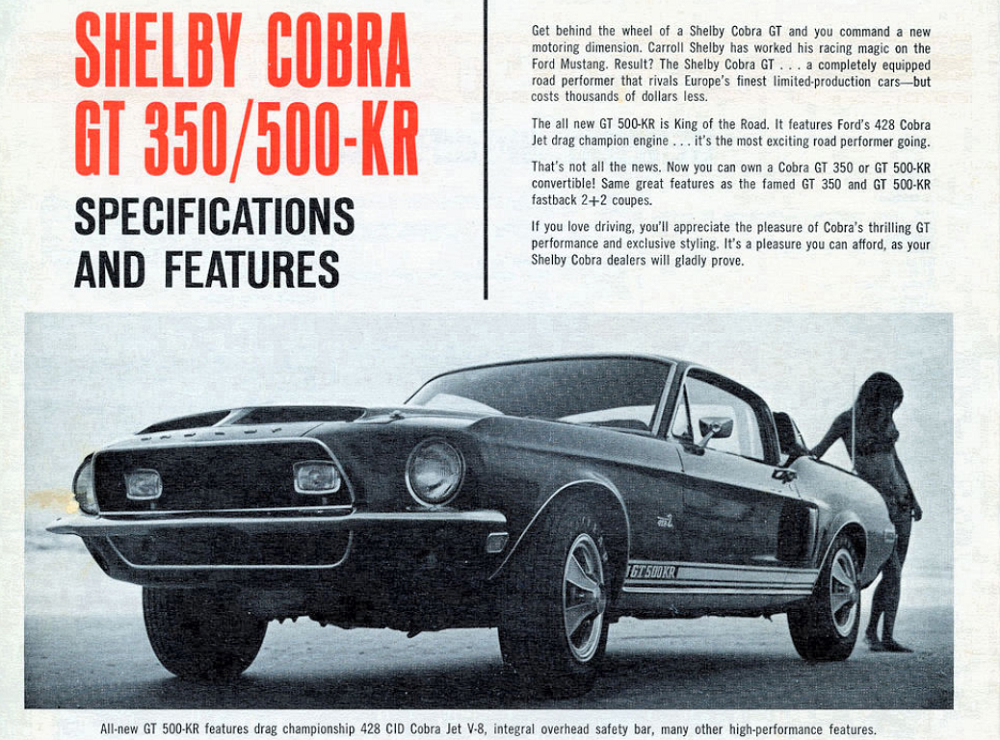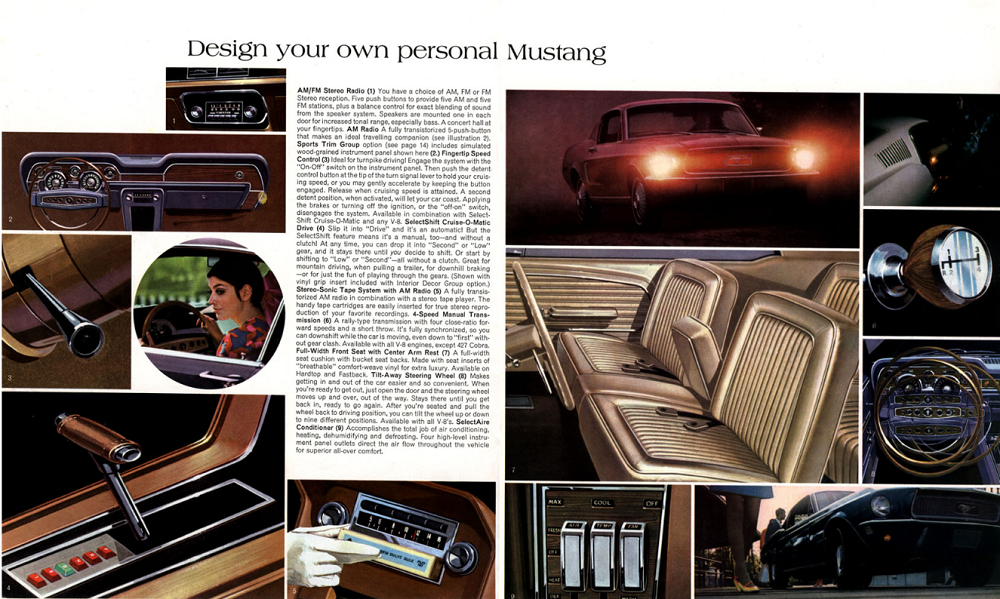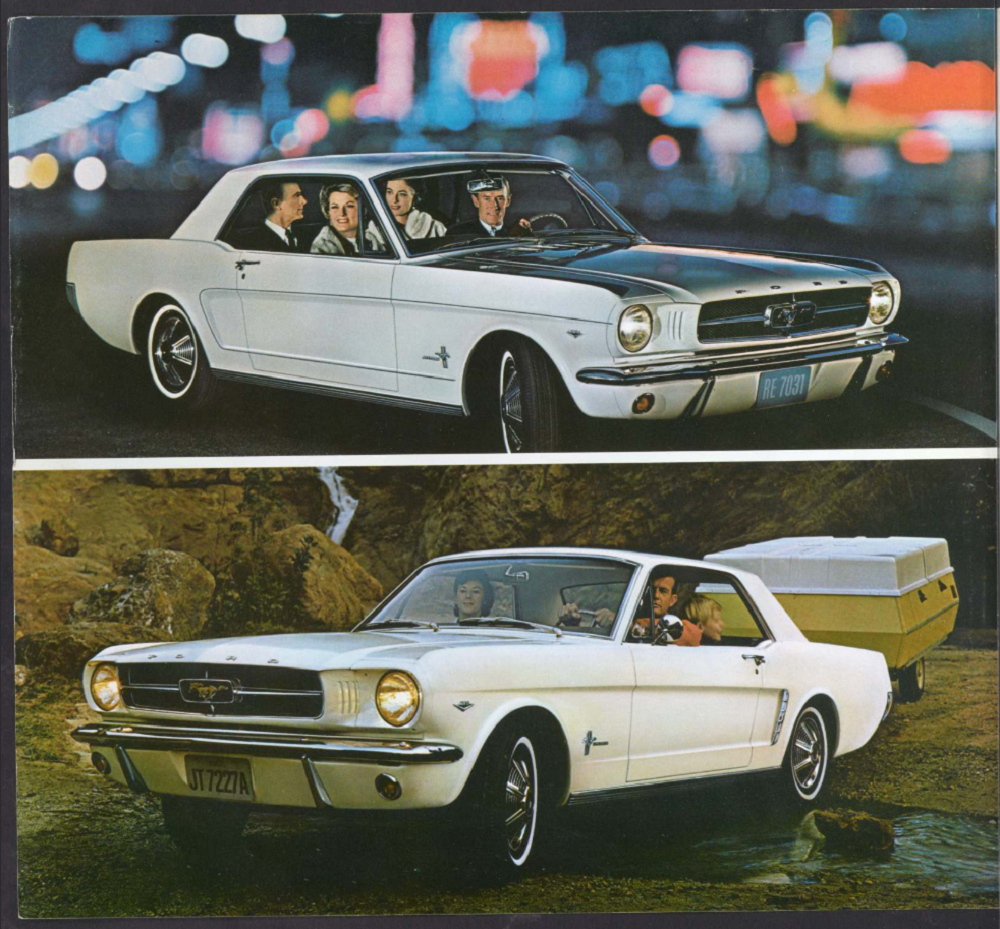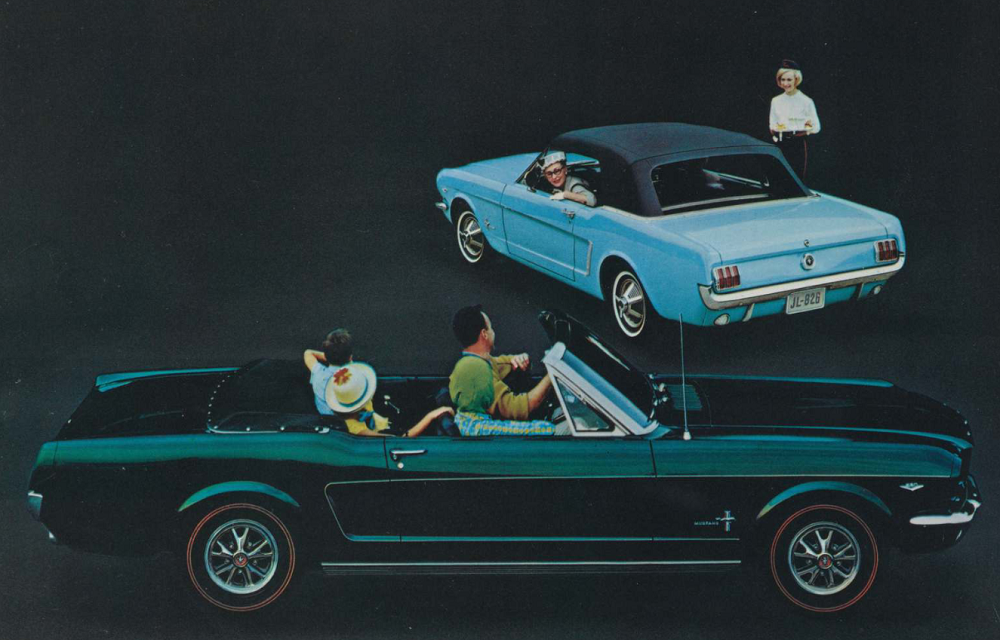60 Years of Mustang: The Original Pony Car (1st Generation Part I, 1964-1968)
On April 17, 1964, Ford released a humble sports car which changed the face of automotive culture forever: the Mustang!
Today we’re celebrating the Ford Mustang’s 60th Birthday with a look back at all seven generations (plus a few extras). Here’s where we’ve been so far —
- The Muscle Mustang (1st Generation Part II, 1969-1973)
- Mustang II (2nd Generation, 1974-1978)
- Fox Body (3rd Generation, 1979-1993)
- SN95 (4th Generation, 1994-2004)
- S197 (5th Generation, 2005-2014)
- S550 (6th Generation, 2015-2023)
- S650 Mustang (7th Generation)
- Saleen: The History of One of Ford’s Greatest Tuning Firms
- The History of Roush: A Household Name in Fast Fords
The first-generation Mustang became a cultural icon quite literally overnight. Its debut set multiple records, chief among them being its utterly staggering popularity. Ford accepted 22,000 orders at the 1964 World’s Fair alone, and sold 680,989 Mustangs by the end of the 1965 model year. A record which had never been broken by any other original car. It remains one of the only sports cars that transcended the relatively niche gearhead culture to become an icon of Americana, as recognizable as baseball and the Statue of Liberty. And certainly the most popular and well-regarded worldwide, by far.
The Mustang’s story began long before sports cars were ever so popular, dating back to the early days of the automobile. It’s a history inexorably woven into the very fabric of motorsports in general, as well as Ford as a company. The original business model of the Model T, as envisioned by Henry Ford, envisioned an affordable, practical motorcar. A sentiment which led to Ford pioneering the development of mass-produced, inexpensive, and reliable transportation. It’s this popularity that endeared Ford to millions of people around the world in the first place, and set the stage for Ford’s next major triumph.
By the 1950s, the US automotive scene revolved around large, ostentatious sedans and coupes. However, that didn’t diminish the average American’s desire to go fast. Following the Prohibition Era, sports cars became contemporary objects of rebellious desire, giving rise to the grassroots of contemporary motorsport with drag racing and stock cars. Chevrolet became the first manufacturer to exploit this untapped market when, in 1953, they debuted America’s first compact sports car, the Corvette. Based on a far more European design aesthetic, the early Corvette was small, svelte, fast, exotic, and unpopular. It didn’t truly come into its own for a few years, when Chevrolet fitted it with a V8 and 4-speed. But it largely remained a niche vehicle, more of a touring car than anything. Similarly, European vehicles such as the Jaguar E-Type proved popular within the enthusiast community, but were expensive and complex for the time.
What the public really needed was a small, affordable, and stylish American sports car. Something with the feel, size, and handling of a GT coupe. But the practicality and simplicity of a regular middle-class family car. A niche picked up by Lee Iacocca, Vice President and General Manager of Ford.
Forging a Dream into Reality
 Image by Joe Ross (Flickr)
Image by Joe Ross (Flickr)
Iacocca realized his vision thanks to his extensive background in marketing, engineering, and forward-thinking. Hired as VP in November 1960, the Mustang became the highlight of his early executive career. Ford’s first crack at the sports car puzzle began under his watch, which bore fruit in the exotic shape of the Mustang I concept car. Supposedly, designer Philip Clark coined the name after a shot of inspiration from some wild horses he saw while traveling. In terms of concept, the Mustang I is a mid-engined, shark-nosed go-kart. Powered by a bespoke 1.5L V4 engine and weighing just 1,544 pounds, the car was initially conceived as essentially a mini-Corvette. Something which evoked the feel of going fast, but on a budget. The test bed itself remained purely experimental. But proved pivotal to Iacocca, who saw potential in its development into a proper production sports car.
Another story claims the Mustang I was named after the North American P-51 Mustang by executive stylist (and aviation enthusiast) John Najjar Ferzely.
Ford debuted the car at Watkins Glen during the 1962 US Grand Prix on October 7. And the result generated overwhelming buzz surrounding Ford’s answer to the Corvette. The Mustang I made multiple appearances at car shows after the Grand Prix, promising an affordable and fast sports car. The public ate it up, and Iacocca used the massive popularity to its fullest advantage.
Before the Mustang I even hit the center stage, Iacocca already dreamt up the initial template for what became the Mustang. Namely: the car must seat four, have bucket seats, a floor-mounted shifter, weigh 2500 pounds or less, and be no longer than 180 inches. In 1961, Iacocca pitched the template to Vice President of Design, Gene Bordinat, who commissioned an intramural design competition for the new sports car. The contest, between studios at Ford, Lincoln-Mercury, and Advanced Design, resulted in Ford’s entry winning the bid.
Joe Oros’ team at Ford Design Studio, composed of L. David Ash, Gale Halderman, John Foster, and George Schumacher penned the final concept, nicknamed “Cougar.” It took two years of development before everything was more or less finalized, but the sketches Halderman drew remained largely the same. By that point, the publicity behind a Ford sports car became a self-sustaining avalanche.
The Mustang Debuts
Ford marketed the Mustang as an upcoming Falcon-based sports car with good performance, styling, and room for four. In 1963, they released their first teaser: the Mustang II concept. Which more or less resembled a heavily stylized Mustang, and later served as a test bed throughout the early 70s. Behind the scenes, Ford froze the final design and set production for early 1964. The first Mustangs rolled off the production line in March before being shipped in mid-April to dealerships, ahead of its official scheduled debut at the World’s Fair. Marketing heavily emphasized the car’s sportiness and curvy lines. Which wound up appealing to people of all walks of life.
Young men and women, licensed to drive early Baby Boomers, motoring enthusiasts, and suburbanites alike flocked to the Mustang. It had lines that were, at once, handsome and effeminate. The engines produced good power and had proven reliability. It featured all the sports car bells and whistles, like the lightweight chassis (2,445 pounds for the base model) and a floor shift. The now-timeless body appealed to people of all ages and wallet sizes. And was an instant sensation the second it debuted on April 17, 1964. Initial sales produced unprecedented records, and contemporary critics raved about the marriage of exotic but relatable styling with the outstanding powertrain selection.
Initially, the Mustang had a few engine options. Namely, a 170c.i. Thriftpower I6, producing 105 horsepower, with optional 260 small-block with 164 horsepower. But the one everyone wanted was the “Challenger,” the 289c.i. V8. Early models came equipped with either the 210-horsepower unit, or the later K-Code HiPo (first available in June 1964). An engine that became one of the most ubiquitous and dominant engines in circuit racing.
After the initial production run, you could order 289s in three flavors. You had the 200-horsepower 2-barrel carburetor, the 225-horsepower 4-barrel, or the K-code. The latter two of which equipped the “GT Package,” the premium sports-oriented Mustang. This set the stage for one of the car’s best selling points: its heavy personalization. You could order a Mustang in a huge number of configurations. A lowly six-cylinder with a 3-speed and basic interior. Or an undiluted monster with a 4-speed and an engine that put out nearly three times the horsepower. All from a car which was two-thirds the price of a Corvette.
The Birth of the Pony Car Era
The Mustang’s cultural phenomenon rocked the automotive world like no other 1960s vehicle. A fact that kick-started what became known as the Pony Car. Named for the Mustang itself, a pony car largely follows the same principles. An inexpensive, performance-oriented, lightweight car with a powerful engine and seating for four. The Barracuda actually preceded the Mustang’s release by a few months. But thanks to the concepts, development time, and marketing hype, the Mustang became the true trendsetter. It quickly monopolized the market for such a car in the US, leading to the rapid development of competitors like the Camaro.
Meanwhile, it proved equally dominant in circuit car racing, setting a new benchmark for small-block V8 coupes. This soaring popularity helped garner publicity for the 1966 inaugural Trans-Am series. In addition to debuting a number of influential and prominent racing drivers, like Jack Roush and Steve Saleen.
The Mustang platform more or less ruled both street and circuit for much of the mid-60s, at least in terms of sheer volume. A fact helped by the insane customizability of the car. Option packages included everything from luxury features to pure racing-oriented upgrades. Carroll Shelby’s package proved the most savage of all, debuting the Shelby Mustang in 1965. The Shelby GT-350 was released to critical acclaim, becoming one of the first true homologation-special Fords. By 1967, Shelby somehow managed to stuff a whole 428 FE engine in a Mustang. Shelby coined it as the GT500, the first of the true big block Mustangs, with an absolute unit of an engine turning the pony car into a missile. These adolescent Mustangs, between about 1965-1967, proved to be the absolute pinnacle of the Pony Car Era.
Redesigning Perfection
1967 saw the first true facelift of the Mustang. Which by later standards was comparatively mild, but did allow for that all-important big block. Influenced by the Muscle Car Era, the Mustang grew slightly in proportions but massively in power. Of course, Ford still offered it in the 289 or straight-six. But if you wanted bigger, you now had the option of the S-code 390, producing 335 horsepower. Or, again, the infamous R-Code GT500. Also producing a claimed “335 horsepower.” Shelby’s GT500 grew even bolder the following year, debuting the 1968 GT500-KR. Which, appropriately, stood for “King of the Road.”
Overall size naturally increased, though only by a couple of inches. This allowed for some additional features like better cargo space, legroom, and so on. At a glance, the easiest way to tell a ‘67-68 facelift is with the concave taillights. Interior-wise, it was mostly a case of shifting around what was standard versus optional, and on what packages. The most obvious of which being the two-spoke energy-absorbing steering wheel of 1968.
Essentially, the 1967 facelift only truly iteratively improved on the original design rather than totally reworking it. Most design elements, inside and out, kept true to the original formula. However, fitting the big block necessitated underpinning alterations, resulting in a fairly substantial weight increase to 2,758 pounds. Over 300 pounds heavier than the equivalent base-model.
Ultimately, the big-block Gen 1’s proved popular in proportion to total production numbers, but sales remained comparatively low. Although “low” is a bit misleading – they easily outsold just about every other sports car. But ‘65-66 model years sold two-thirds more Mustangs than ‘67-68. Which, granted, is still almost 800,000 Mustangs sold in two years alone. And while the small block easily made up the lion’s share of sales, the big block left a lasting impression on buyers. Especially GT500 owners, who likely stepped on the throttle and very quickly learned how much respect to give such a savage automobile.
The Lasting Legacy of the Original Mustang
Whether small or big block, standard, Deluxe, or GT; base or Shelby. The first-generation Mustang is, in all forms, an utterly iconic part of American history. This year, we celebrate its 60th Anniversary and recognize the contributions it made to motoring culture as a whole. The Mustang single-handedly fostered an entire automotive era named after it. The platform became one of the winningest American cars of all time, with its balance and ease of maintenance endearing it to clubsports and professionals across America. Ford produced Mustangs across no less than eight facilities. In the US, Ford had Dearborn, Michigan, Metuchen, New Jersey, and San Jose, California. That’s in addition to Australia (for RHD conversion), Mexico City, Amsterdam, Lima, and Valencia. In total, Ford produced 2,078,112 Mustangs up to and including 1968.
These days, no one, including Ford themselves, has surpassed the original Mustang in terms of initial sales. Original examples remain contemporary and timeless, with the reliability and power to keep pace and exceed modern traffic. It set a new benchmark for compact, budget-focused performance, which influenced future designs at Ford and beyond when the Oil Crisis struck. The basic elements of the long hood, short trunk, 2+2 or convertible configuration spread overseas as well, helping rekindle the GT flame in Japan. The Mustang featured heavily in contemporary media, either through advertising or movie appearances. From its film debut in The Troops of St. Tropez to classics like Goldfinger and Bullitt, the car was absolutely everywhere.
At its height, there was one Mustang for every 97 American citizens. Its insane popularity and pragmatically excellent design and construction left an indelible impression on America. A legacy that lives on today, thanks to its styling, performance, affordability, and ease of maintenance. A truly iconic car, with a surprisingly nuanced and layered history underneath the hood.
Images from the Ford Heritage Vault
Brochures used: 1964-1968 Ford Mustang, 1964 Ford Full Line, 1953 Corvette, 1968 Shelby.

